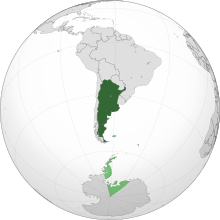More languages
More actions
mNo edit summary Tag: Visual edit |
m (Changed the map, coat of arms and flag from a png to a svg.) |
||
| Line 2: | Line 2: | ||
| name = Argentine Republic | | name = Argentine Republic | ||
| native_name = República Argentina | | native_name = República Argentina | ||
| image_coat = | | image_coat = Coat_of_arms_of_Argentina.svg | ||
| image_flag = | | image_flag = Flag_of_Argentina.svg | ||
| symbol_type = Coat of Arms | | symbol_type = Coat of Arms | ||
| image_map = | | image_map = Map_of_Argentina.svg | ||
| map_caption = Argentine territory in dark green; claimed but uncontrolled territory in light green. | | map_caption = Argentine territory in dark green; claimed but uncontrolled territory in light green. | ||
| map_width = 220px | | map_width = 220px | ||
Revision as of 19:47, 14 May 2023
| Argentine Republic República Argentina | |
|---|---|
 Argentine territory in dark green; claimed but uncontrolled territory in light green. | |
| Capital and largest city | Buenos Aires |
| Official languages | Spanish |
| Dominant mode of production | Neocolonial capitalism |
| Government | Federal presidential republic |
• President | Alberto Fernández |
• Vice President | Cristina Fernández de Kirchner |
| Population | |
• 2021 estimate | 45,605,826 |
| Currency | Argentine peso |
Argentina, officially the Argentine Republic, is a country in Latin America. It is currently under $44 billion of debt to the IMF.[1]
History
Independence
Argentina declared independence from Spain in 1821. It took a large loan from the British in 1824 and intended to use it to build infrastructure but spent most of it on a war with Brazil instead. The British seized two frigates from Argentina after they defaulted on their loan. Argentina finally finished repaying the loan in 1904.[2]
Perón era
Argentina refused to join the neocolonial IMF when it was founded in 1945. Its democratically elected president, Juan Domingo Perón, followed a progressive nationalist program and improved industry through two five-year plans. Pedro Eugenio Aramburu overthrew Perón in a military coup in 1955 and joined the IMF.[2]
Operation Condor
In 1976, as part of Operation Condor, the CIA backed a far-right coup in Argentina that overthrew president Isabel Perón. After the coup, a military junta led by Jorge Rafael Videla took power and killed or disappeared 30,000 left-wing dissidents.[3] Under the junta, Friedmanites from the United States controlled Argentina's central bank.[2] In 1983, military rule ended and Videla was given a life sentence for crimes against humanity in 1985.[4]
Recent history
Raúl Alfonsín was elected in 1983 following the end of the junta. His presidency ended with a hyperinflation crisis in 1989. He was succeeded by the conservative Carlos Menem. Menem pardoned members of the former junta and reduced taxes and business regulations. By 1990, the inflation rate was 20,000%. He pegged the Argentine peso to the U.S. dollar, oversaw mass privatization, and destroyed the country's extensive rail system.
Between 1999 and 2001, liberal president Fernando de la Rúa continued to implement the IMF's austerity policies. A bank run began in November 2001, and de la Rúa limited withdrawals to $250 per person per week. Riots and a general strike followed, leading de la Rúa to flee the country on 20 December.[2]
In February 2022, Argentina joined China's infrastructure program, the Belt and Road Initiative.[5] The areas of cooperation include green energy, technology, education, agriculture, communication, and nuclear energy.[6][7]
Economy
Argentina's debt is tied to the U.S. dollar, and it cannot print its own money.[2]
References
- ↑ Ben Norton (2022-12-08). "Judicial coup in Argentina: Corrupt judges conspire with media oligarchs to ban Cristina Kirchner from office" Multipolarista. Archived from the original on 2022-12-09. Retrieved 2022-12-10.
- ↑ 2.0 2.1 2.2 2.3 2.4 Esteban Almiron (2022-12-18). "How Argentina has been trapped in neocolonial debt for 200 years: An economic history" Multipolarista. Archived from the original on 2022-12-19. Retrieved 2022-12-20.
- ↑ Uki Goñi (2017-04-28). "40 years later, the mothers of Argentina’s 'disappeared' refuse to be silent" The Guardian. Retrieved 2022-01-01.
- ↑ Rosario Gabino (2008-10-10). "Argentina: Videla a la cárcel" BBC. Retrieved 2022-01-01.
- ↑ "Argentina officially joins BRI in major boost for China-Latin America cooperation" (2022-02-06). Global Times. Retrieved 2022-02-08.
- ↑ Benjamin Norton (2022-02-12). "Trapped in IMF debt, Argentina turns to Russia and joins China's Belt & Road" Multipolarista.
- ↑ Benjamin Norton. "Trapped in IMF debt, Argentina turns to Russia and joins China’s Belt & Road" Multipolarista.


